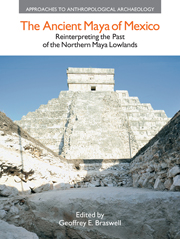Book contents
- Frontmatter
- Dedication
- Contents
- Contributors
- List of Figures
- List of Tables
- 1 The Ancient Maya of Mexico: Reinterpreting the Past of the Northern Maya Lowlands
- Part I THE PRECLASSIC PERIOD
- Part II THE EARLY AND LATE CLASSIC PERIODS
- Part III THE TERMINAL CLASSIC AND EARLY POSTCLASSIC PERIODS
- Part IV THE LATE POSTCLASSIC TO HISTORICAL PERIODS
- Part V CONCLUSIONS
- Index
1 - The Ancient Maya of Mexico: Reinterpreting the Past of the Northern Maya Lowlands
- Frontmatter
- Dedication
- Contents
- Contributors
- List of Figures
- List of Tables
- 1 The Ancient Maya of Mexico: Reinterpreting the Past of the Northern Maya Lowlands
- Part I THE PRECLASSIC PERIOD
- Part II THE EARLY AND LATE CLASSIC PERIODS
- Part III THE TERMINAL CLASSIC AND EARLY POSTCLASSIC PERIODS
- Part IV THE LATE POSTCLASSIC TO HISTORICAL PERIODS
- Part V CONCLUSIONS
- Index
Summary
The three modern Mexican states of Campeche, Yucatan, and Quintana Roo compose roughly half of the Maya area. The northern Maya lowlands, whose southern boundary runs east–west through south central Quintana Roo and Campeche at approximately 19 degrees north latitude, is—with the exception of the Puuc hills—a generally flat plain characterized by low scrub forest, moderate to low rainfall, little surface water, a subtropical climate, and many of the most spectacular cities ever built in the New World. For this reason, the archaeological sites of the Yucatan peninsula, including Chichen Itza, Tulum, Uxmal, and Coba, are among the most visited anywhere in the Americas.
The northern lowlands have long been the focus of Mexican archaeologists studying the Maya. Most of the projects of the past 30 years have been directed by investigators at the Instituto Nacional de Antropología e Historia (INAH) center in Merida, or by investigators at newer INAH centers in Campeche and Chetumal. Other important projects have been conducted by faculty and students at Mexican universities, by foreign scholars, and, recently, by a small group of independent Mexican archaeologists (see Bey 2006:14-15 for a partial publication list of many of these projects). Results of archaeological research in the northern Maya lowlands are regularly presented at meetings held in Mexico, Guatemala, the United States, and Europe.
- Type
- Chapter
- Information
- The Ancient Maya of MexicoReinterpreting the Past of the Northern Maya Lowlands, pp. 1 - 40Publisher: Acumen PublishingPrint publication year: 2012



